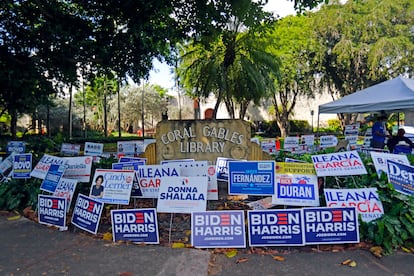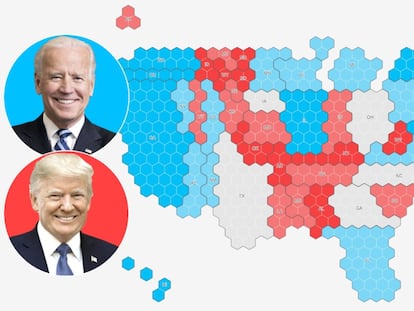Hispanic voters could be key in Arizona, Florida and Pennsylvania
Latinos have become the most important minority in the US this year, and winning their votes in a few key states could deliver victory

Hispanic voters have become the most important minority in the United States this year. Winning their votes in a few key states could turn the election around and deliver victory. There are a projected 32 million eligible Hispanic voters, or 13.3% of the US electorate, higher than the number of eligible African American voters, according to the Pew Research Center. And this number keeps growing every year.
Yet Hispanic voters are not a monolithic group. Out of all Latinos with the right to vote, 59% have a Mexican background, 14% are of Puerto Rican descent, 5% are Cuban American and 22% cite other origins, according to the same research center.
And census data shows that most of them are not immigrants, much less undocumented. Around 75% were born in the US, meaning that their concerns are similar to those of any other US citizen. The coronavirus crisis, health insurance, jobs and wages – those are their primary worries, above and beyond immigration or racial justice, according to Latino Decisions, a Democratically leaning political-opinion research group.
Since the 1980s, Hispanics have traditionally had a low voter turnout at elections compared with other groups. Research shows that while more than 60% of the white or African American population votes, only 48% of Latinos do. Democratic candidate Joe Biden’s campaign staff has expressed concern about insufficient turnout by black and Latino voters in key states such as Florida and Pennsylvania.
Since the 1980s, Hispanics have traditionally had a low voter turnout at elections compared with other groups
Despite record early voting across the country, Biden’s team is on alert mode. In Arizona, with four days to go to Election Day, two-thirds of registered Hispanic voters had not participated. In Florida, neither had half of Latino and black registered voters, but half of white voters had, according to Catalist, a voter-data analysis firm.
The swing states where the Latino vote could be decisive are, above all, Florida, Pennsylvania and Arizona. These states voted red at the 2016 election, and all eyes will be on them today as Hispanic votes could turn the tide toward the Democrats, according to Equis Research, which specializes in this voter group.
In Arizona, which shares one of the longest borders with Mexico and where 24% of the electorate is Hispanic, Trump won by just 90,000 votes four years ago. Equis Research believes that if white voter participation remains steady at 48% and the Latino vote rises to over 18%, Biden could have a chance to win the state. In Pennsylvania, eligible Hispanic voters only make up 6% of the total, but the gap between Republicans and Democrats is so narrow that this group could end up deciding the election.
Florida is a special case. The Hispanic community is divided into those of Cuban and Venezuelan descent on one hand, who traditionally vote Republican, and those of Puerto Rican origin, who lean toward the Democratic Party. In Florida, given a steady white voter turnout of 40%, Biden would need a high turnout and high support levels in order to win.
The Hispanic community, sometimes known as “the sleeping giant,” adds nearly one million young voters every year. Early voting data showed a significant rise in under-30s from every ethnic and racial group in the electorate who had voted in Texas, Florida and North Carolina a week before Election Day. In Texas, six times more people had voted than in 2016, while in Florida it was three times as much. This kind of turnout can in some cases be beneficial to Democrats, although some polls are detecting a growing acceptance of Trump among young, male, conservative Hispanics.
Trump won in 2016 after insulting and criminalizing an entire community, whom he called “rapists and murderers,” and after promising to build a wall between Mexico and the US. After that campaign, Latino support was nearly 30%. Four years later, attention is once again focusing on what Hispanic voters will do.
English version by Susana Urra.
Tu suscripción se está usando en otro dispositivo
¿Quieres añadir otro usuario a tu suscripción?
Si continúas leyendo en este dispositivo, no se podrá leer en el otro.
FlechaTu suscripción se está usando en otro dispositivo y solo puedes acceder a EL PAÍS desde un dispositivo a la vez.
Si quieres compartir tu cuenta, cambia tu suscripción a la modalidad Premium, así podrás añadir otro usuario. Cada uno accederá con su propia cuenta de email, lo que os permitirá personalizar vuestra experiencia en EL PAÍS.
¿Tienes una suscripción de empresa? Accede aquí para contratar más cuentas.
En el caso de no saber quién está usando tu cuenta, te recomendamos cambiar tu contraseña aquí.
Si decides continuar compartiendo tu cuenta, este mensaje se mostrará en tu dispositivo y en el de la otra persona que está usando tu cuenta de forma indefinida, afectando a tu experiencia de lectura. Puedes consultar aquí los términos y condiciones de la suscripción digital.
More information
Últimas noticias
Most viewed
- Reinhard Genzel, Nobel laureate in physics: ‘One-minute videos will never give you the truth’
- Oona Chaplin: ‘I told James Cameron that I was living in a treehouse and starting a permaculture project with a friend’
- Pablo Escobar’s hippos: A serious environmental problem, 40 years on
- Why we lost the habit of sleeping in two segments and how that changed our sense of time
- Chevy Chase, the beloved comedian who was a monster off camera: ‘Not everyone hated him, just the people who’ve worked with him’











































